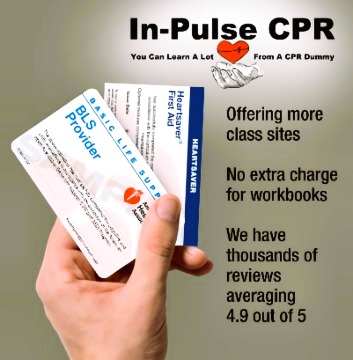Florida, Minnesota
Pennsylvania, Tennessee
Bloodborne pathogens? Helpful information regarding this potentially dangerous topic. At In-Pulse CPR we offer local CPR/First Aid and Bloodborne Pathogens training classes across the metro area. Click on "Class Calendar" above for your state's classes locations and times.
- What is Bloodborne Pathogens Training? May 25, 2022Donna RyanThe Occupational Safety and Health Administration (OSHA) supports bloodborne pathogens training. It is used to prevent the spread of bloodborne pathogens or viruses. The main pathogens include hepatitis B, hepatitis C, and the human immunodeficiency virus (HIV). Bloodborne pathogens training is not limited to healthcare workers. Therefore, anyone who works with or around patients can benefit ...
- How do bloodborne pathogens spread? May 13, 2022Siam BBlood-borne pathogens spread when an infected individual comes into contact with an uninfected individual. But what type of contact and how much contact is necessary for actual transmission to occur? The two main methods of transmission of blood-borne pathogens include sharing of hypodermic needles (eg illicit drug use) and sexual activity. In addition, one can also ...
- Presentation of Common Bloodborne Pathogens Part 2 May 3, 2022Siam BEven though there are many blood-borne pathogens, the three that account for the majority of cases include hepatitis B, hepatitis C, and HIV. Hepatitis B The cause of Hepatitis B is the hepatitis B virus; the primary injury is inflammation of the liver- which can be acute or chronic. In the acute phase, the infection will last ...
- Bloodborne Pathogens Part 1 May 1, 2022Siam BAll individuals who work in a clinical setting, medical laboratory, healthcare institution, or research facility may come in contact with body fluids from another person. This places them at high risk for coming into contact with bloodborne pathogens. But what are bloodborne pathogens? Blood-borne pathogens are organisms (viruses, bacteria, fungi) that can cause potentially serious and ...
- Bloodborne Pathogens: Where They Are and How They Are Transmitted August 12, 2016Elizabeth Di VergigelisWhen considering bloodborne pathogens most people believe that in order to be contaminated by these pathogens they must come in contact with the infected person’s blood in some way into a bodily orifice such as the mouth or nose to become contaminated, as well. But, it is a highly mistaken misnomer of the fact that ...
- Protecting yourself Against Bloodborne Pathogens in a Health Care Setting February 15, 2012Donna RyanOccupations at Risk If you work in a number of occupations, particularly in nursing or as an emergency medical technician (EMT), you are at a pronounced risk of being exposed to bloodborne pathnogens (BBPs). Other occupations that stand the risk of infection from BBPs include police officers, firemen, clinical or laboratory workers, plumbers, hair stylists, and ...
- Proper precautions and training can prevent the spread of bloodborne pathogens December 13, 2011Pearl Salkinwritten by Pearl Salkin | If a lab technician at a major medical research center in the United States drops a glass beaker on a counter and it breaks, it’s highly unlikely that any bloodborne pathogen that might be present will find a series of human hosts and cause a worldwide epidemic. Such facilities fall under ...
Blog Categories: What is CPR? | Why do we need CPR training? | Why do we need AED training? | Why do we need First Aid training? | Who needs Bloodborne Pathogens training? | What employers need to know about CPR training for their staff | Staying Healthy | Avoiding Injuries | Tributes to those who help make our lives safe | Survival stories | CNA Blog



